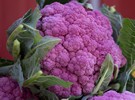Purple cauliflower, carrots  and broccoli are now joining eggplant, beetroot and cabbage on Australia’s supermarket shelves. Tim Nitschke, who manages Coles’ vegetables category: “We dabbled in purple and orange cauliflower back in 2011 and 2012 but our customers weren’t quite ready for it back then. We started selling them again in 2019 and in the last 12 months they have really taken off.’’
and broccoli are now joining eggplant, beetroot and cabbage on Australia’s supermarket shelves. Tim Nitschke, who manages Coles’ vegetables category: “We dabbled in purple and orange cauliflower back in 2011 and 2012 but our customers weren’t quite ready for it back then. We started selling them again in 2019 and in the last 12 months they have really taken off.’’
The supermarket chain has introduced a number of purple vegetable varieties over the past year, including purple asparagus, purple basil microherbs, kalettes (a curly cross between brussels sprouts and kale) and red darling brussels sprouts. “We recently started selling purple broccolini in some stores,” Nitschke told theguardian.com.
The produce’s rich colors are totally natural. The purple color is a flavonoid called anthocyanin, which also contributes to deciduous trees’ leaves turning red in the autumn. Depending on their pH, anthocyanin pigments can appear as red, purple, blue and black in fruits and vegetables; a reaction that comes to life in the kitchen when you squeeze lemon over a head of purple cauliflower, which promptly blushes pink.
Photo source: Dreamstime.com


